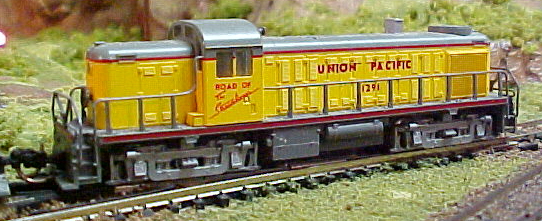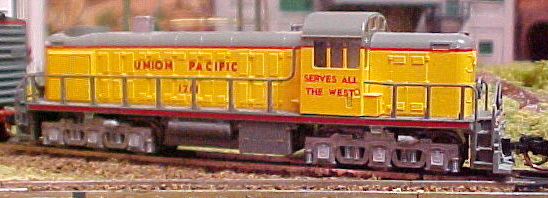



Introduced: 1999 (both)
These models are virtually identical (both internally and externally), so to save myself a bit of time I'm going to cover them both here. The main difference is the trucks, with the RS-2 having two-axle trucks and the RSC-2 having three-axle trucks. The only other difference I can detect is the orientation of the exhaust stacks - the RSC-2 comes with a lengthwise stack (indicating an air-cooled turbocharger), while the RS-2 comes with either a lengthwise stack or a crosswise stack (the latter indicating a water-cooled turbocharger). Both models share the exact same chassis / mechanism -
These Alcos employ all of the time-honored design features one normally associates with "modern" Kato diesels - shell-mounted couplers, split-frame DCC-Ready metal chassis, dual-flywheels, low-friction drive, plastic truck assemblies, plastic gearing, blackened wheels, all-wheel drive, and all-wheel pick-up (no traction tires). The motor is an open-sided 5-poler. Directional lighting is provided by a PC board mounted on top of the chassis (in the above picture, I've swapped out the stock lightboard for a Digitrax decoder). Wheels are low-profile and have no problems on Code-55 track.
To date there's just been the one (1999) production run of these models. The couplers on this initial release were Rapidos (albeit easily swapped out for MT's). One would assume that should Kato ever decide to make another run of these models they will come with Kato's proprietary "semi-automatic" knuckle couplers. But given Kato's nigh incomprehensible decision-making process (vis'a'vis second runs), it's anyone's guess when/if that will ever happen.
Performance on these models is perfect in every way - smooth, quiet, flawless pickup and throttle response, great pulling power, etc.
Shell removal is pretty simple - just take hold of the fuel tank with one hand and the shell with the other, then just sort of wiggle the shell up and off.
Grade: A (for both)
RSC-2 reviewed: 6/99 Model Railroader ("Kato's model has an injection-molded styrene shell with separate cab. The grab irons, fan, and radiator louvers are molded in place on the shell, while the exhaust stack, horn, brake wheel, window glazing, and headlight lenses are separate details. The molded detail is sharp. Of particular note is the radiator fan, which has simulated fan blades visible, and the fuel filler and sight glass on each side of the cab. The lengthwise exhaust stack marks the locomotive as having an original air-cooled turbocharger. When these were replaced with water-cooled turbochargers (most during the 1950s) the stack was moved crosswise to the hood. Kato is offering this variation on its coming RS-2 models, which should be out by the time you read this review. Small tabs under the shell at the front and back hold it to the chassis. To remove the shell, first pop the ends the handrails out of the cab, then grip the shell and gently rock it back and forth while pulling up. The walkway/handrail/corner step assembly is separate, as is the combination side sill and pilot piece. The truck sideframes (a single piece for each truck) are black acetal plastic, with all details molded in place. Most of the model's dimensions match nicely (prototype) drawings... However, the radiator fan is about a scale 4" too tall - just enough to be noticeable. A split zinc-alloy frame encloses a 5-pole, skew-wound motor. The motor, with a flywheel at each end, turns brass worms above each truck. These drive gears in the truck towers, which power all six axles. Operation is fairly smooth with decent starting and low-speed action, but you'll only use the lower third of your speed control as the model is already well above prototype speeds at six volts. The RSC-2's .52 ounces of drawbar pull is equal to about 13 cars on straight, level track... All of the wheelsets on our sample matched an NMRA standards gauge, but wheels were a tad deeper (about .010") than the NMRA's RP25 profile. The paint on our Chicago, Milwaukee, St.Paul & Pacific sample was neatly applied, and the lettering was fairly sharp and legible. This is a fine model that will be right at home on branchline layouts. Undec, CMSP&P, SAL, UP. $92.98")